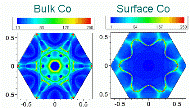Department of Physics and Astronomy: Publications and Other Research
Date of this Version
September 2006
Abstract
We investigate the causes of electron-circular dichroism (ECD) in bromocamphor and dibromocamphor, focusing specifically on the electron helicity density of the target. Using electron transmission spectroscopy (ETS) and quantum chemical calculations, we have observed and assigned temporary negative ion states of bromocamphor and dibromocamphor. Further calculations were conducted to determine the helicity densities of these compounds. Large helicity densities are found in the regions of large wave function amplitude of the normally unoccupied molecular orbitals responsible for resonances in the scattering cross sections. We relate our ETS assignments and helicity density results to the chiral asymmetry data observed in electron-circular dichroism experiments by the Münster group (Nolting et al 1997 J. Phys. B: At. Mol. Opt. Phys. 30, 5491). Our results support helicity density as a possible source of chiral asymmetry at certain resonance positions in bromocamphor and dibromocamphor.


Comments
Published in Journal of Physics B: Atomic, Molecular and Optical Physics 39 (2006), pp. 2169–2181. Copyright © 2006 Institute Of Physics/IOP Publishing. Used by permission. doi:10.1088/0953-4075/39/9/006 Online at stacks.iop.org/JPhysB/39/2169.